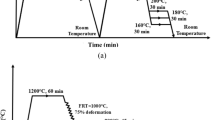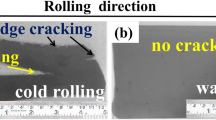Abstract
The microstructure and properties in the 1000 MPa grade hydropower steel during “quenching + tempering” process was investigated. Key microstructural parameters such as effective grain size, carbon content of martensitic matrix, and dislocation density were analyzed by scanning electron microscope, x-ray diffraction and electron backscatter diffraction. Tensile properties and Charpy V-notch (CVN) impact toughness of experimental steels were measured, enabling quantitative analysis of the relationship between microstructure and yield strength, ductile-to-brittle transition temperature (DBTT). Results show that, after quenching at 890 °C and tempering at 630 °C for 120 min, the effective grain size was limitedly refined to 1.70 μm. The carbon content of martensitic matrix is reduced to 0.0154 pct, and the dislocation density decreased to 3.63 × 1014 m−2. Accordingly, the grain refinement strengthening, solid solution strengthening and dislocation strengthening amounted to 422, 138 and 93 MPa, respectively. The DBTT was reduced to −81 °C, and the contribution from grain refinement, dislocation and precipitation strengthening and microstructure heterogeneity was −308, 140 and 124 °C, respectively. The improvement in DBTT compared to that tempered at 630 °C for 15 min was mainly related to the decrease of dislocation density and ripening of precipitated particles, i.e., the increased plastic deformability of martensitic lattice.












Similar content being viewed by others
References
N. Hara and M. Sato, Conference on High Strength Steels for Hydropower Plants, Japan
K. Horikawa and N. Watanabe, Conference on High Strength Steels for Hydropower Plants, Japan, 2008.
S.Q. Zhang, X.F. Hu, H.Y. Pang, Y.B. Du, H.C. JIang, and L.J. Rong, Cross-Section Effect of Ni-Cr-Mo-B Ultra-Heavy Steel Plate for Offshore Platform, Acta Metall. Sin., 2020, 56, p 1227–1238.
J.S. Guan, Q. Yuan, Z.Q. Xiong, Q.X. Zhang, and G. Xu, Effects of Q&T Parameters on Phase Transformation, Microstructure, Precipitation and Mechanical Properties in a PS-30Cr2Nb Pipeline Steel, Mater. Res. Express, 2020, 7, p 016536.
J. Wang, Z.N. Xu, and X.F. Lu, Effect of the Quenching and Tempering Temperatures on the Microstructure and Mechanical Properties of H13 Steel, J. Mater. Eng. Perform., 2020, 29, p 1849–1859.
Z.J. Xie, C.J. Shang, X.L. Wang, X.M. Wang, G. Han, and R.D.K. Misra, Recent Progress in Third-Generation Low Alloy Steels Developed Under M3 Microstructure Control, Int. J. Miner. Metall. Mater., 2020, 27, p 1–9.
C.W. Li, L.Z. Han, G.H. Yan, Q.D. Liu, X.M. Luo, and J.F. Gu, Time-Dependent Temper Embrittlement of Reactor Pressure Vessel Steel: Correlation Between Microstructural Evolution and Mechanical Properties During Tempering at 650 °C, J. Nucl. Mater., 2016, 480, p 344–354.
Z.Y. Zhang, F. Chai, X.B. Luo, G. Chen, C.F. Yang, and H. Su, The Strengthening Mechanism of Cu Bearing High Strength Steel as-Quenched and Tempered and Cu Precipitation Behavior in Steel, Acta Metall. Sin., 2019, 55, p 783–791.
J. Chen, C.S. Li, J.Y. Ren, X.Y. Tu, and L.Q. Chen, Strength and Toughness of Fe-1.2Mn-0.3Cr-1.4Ni-0.4Mo-C Tempered Steel Plate in Three Cooling Processes, Mater. Sci. Eng. A, 2019, 754, p 178–189.
W. Hou, Q.D. Liu, and J.F. Gu, Improved Impact Toughness by Multi-Step Heat Treatment in a 1400 MPa Low Carbon Precipitation-Strengthened Steel, Mater. Sci. Eng. A, 2020, 797, p 140077.
J. Hufenbach, L. Giebeler, M. Hoffmann, S. Kohlar, U. Kuhn, T. Gemming, S. Oswald, B. Eigenmann, and J. Eckert, Effect of Short-Term Tempering on Microstructure and Mechanical Properties of High-Strength FeCrMoVC, Acta Mater., 2012, 60, p 4468–4476.
T. Jia, Y.L. Zhou, X.X. Jia, and Z.D. Wang, Effects of Microstructure on CVN Impact Toughness in Thermomechanically Processed High Strength Microalloyed Steel, Metall. Mater. Trans. A, 2016, 48, p 685–696.
P. Yan, Z. Liu, H. Bao, Y. Weng, and W. Liu, Effect of Tempering Temperature on the Toughness of 9Cr–3W–3Co Martensitic Heat Resistant steel, Mater. Des., 2014, 54, p 874–879.
K. Chen, Z.H. Jiang, F.B. Liu, J. Yu, Y. Li, W. Gong, and C.Y. Chen, Effect of Quenching and Tempering Temperature on Microstructure and Tensile Properties of Microalloyed Ultra-High Strength Suspension Spring Steel, Mater. Sci. Eng. A, 2019, 766, p 138272.
R.N. Caron and G. Krauss, The Tempering of Fe-C Lath Martensite, Metall. Trans., 1972, 3, p 2381–2389.
R. Ranjan and S.B. Singh, Martensite Transformation During Continuous Cooling: Analysis of Dilatation Data, Metall. Mater. Trans. A, 2018, 49, p 4474–4483.
Y. Lu, H.X. Yu, and R.D.S. Jr., The Effect of Carbon Content on the c/a Ratio of as-Quenched Martensite in Fe-C alloys, Mater. Sci. Eng. A, 2017, 700, p 592–597.
B. Hutchinson, J. Hagstrom, O. Karlsson, D. Lindell, M. Tornberg, F. Lindberg, and M. Thuvander, Microstructures and Hardness of as-Quenched Martensites (0.1–0.5%C), Acta Mater., 2011, 59, p 5845–5858.
E.I. Galindo-Nava and P.E.J. Rivera-Díaz-del-Castillo, A Model for the Microstructure Behaviour and Strength Evolution in Lath Martensite, Acta Mater., 2015, 98, p 81–93.
F. HajyAkbary, J. Sietsma, A.J. Böttger, and M.J. Santofimia, An Improved x-ray Diffraction Analysis Method to Characterize Dislocation Density in Lath Martensitic Structures, Mater. Sci. Eng. A, 2015, 639, p 208–218.
T. Ungár and A. Borbély, The Effect of Dislocation Contrast on x-ray Line Broadening: A New Approach to Line Profile Analysis, Appl. Phys. Lett., 1996, 69, p 3173–3175.
S. Dixit, V. Chaudhari, and D.M. Kulkarni, Effect of Tempering Time on Mechanical and Fracture Behavior of SA 387 Gr.11 Pressure Vessel Steel, J. Mater. Process. Technol., 2020, 276, p 116419.
F. Christien, M.T.F. Telling, and K.S. Knight, Neutron Diffraction in situ Monitoring of the Dislocation Density During Martensitic Transformation in a Stainless Steel, Scr. Mater., 2013, 68, p 506–509.
S. Morito, J. Nishikawa, and T. Maki, Dislocation Density Within Lath Martensite in Fe–C and Fe–Ni Alloys, ISIJ Int., 2003, 43, p 1475–1477.
S. Takebayashi, T. Kunieda, N. Yoshinaga, K. Ushioda, and S. Ogata, Comparison of the Dislocation Density in Martensitic Steels Evaluated by Some x-ray Diffraction Methods, ISIJ Int., 2010, 50, p 875–882.
J. Pešička, R. Kužel, A. Dronhofer, and G. Eggeler, The Evolution of Dislocation Density During Heat Treatment and Creep of Tempered Martensite Ferritic Steels, Acta Mater., 2003, 51, p 4847–4862.
B. Kim, E. Boucard, T. Sourmail, D.S. Martín, N. Gey, and P.E.J. Rivera-Díaz-Del-Castillo, The Influence of Silicon in Tempered Martensite: Understanding the Microstructure-Properties Relationship in 0.5–0.6wt.% C Steels, Acta Mater., 2014, 68, p 169–178.
Q.L. Yong, Secondary phase in steels, Metallurgical Industry Press, Beijing, 2006.
Q.H. Wang, Q.B. Ye, Z.D. Wang, L.Y. Kan, and H.T. Wang, Thickness Effect on Microstructure, Strength, and Toughness of a Quenched and Tempered 178 mm Thickness Steel Plate, Met., 2020, 10, p 572.
I. Gutiérrez, Effect of Microstructure on the Impact Toughness of Nb-Microalloyed Steel: Generalisation of Existing Relations from Ferrite-Pearlite to High Strength Microstructures, Mater. Sci. Eng. A, 2013, 571, p 57–67.
N. Isasti, D.J. Badiola, M.L. Taheri, and P. Uranga, Microstructural Features Controlling Mechanical Properties in Nb-Mo Microalloyed Steels. Part II: Impact Toughness, Metall. Mater. Trans. A, 2014, 45, p 4972–4982.
H.B. Liu, H.Q. Zhang, and J.F. Li, Thickness Dependence of Toughness in Ultra-Heavy Low-Alloyed Steel Plate After Quenching and Tempering, Metals, 2018, 8, p 628.
L.Y. Lan, C.L. Qiu, D.W. Zhao, X.H. Gao, and L.X. Du, Microstructural Characteristics and Toughness of the Simulated Coarse Grained Heat Affected Zone of High Strength Low Carbon Bainitic Steel, Mater. Sci. Eng. A, 2011, 529, p 192–200.
B. Hwang, S. Lee, Y.M. Kim, N.J. Kim, and J.Y. Yoo, Correlation of Rolling Condition, Microstructure, and Low-Temperature Toughness of X70 Pipeline Steels, Metall. Mater. Trans. A, 2005, 36, p 1793–1805.
C.F. Wang, M.Q. Wang, J. Shi, W.J. Hui, and H. Dong, Effect of Microstructural Refinement on the Toughness of Low Carbon Martensitic Steel, Scr. Mater., 2008, 58, p 492–495.
T. Furuhara, K. Kobayashi, and T. Maki, Control of Cementite Precipitation in Lath Martensite by Rapid Heating and Tempering, ISIJ Int., 2004, 44, p 1937–1944.
K.H. Lee, M.J. Jhung, M.C. Kim, and B.S. Lee, Effects of Tempering and PWHT on Microstructures and Mechanical Properies of SA508 Gr. 4N, Nucl. Eng. Technol., 2014, 46, p 413–422.
S.Y. Shin, K.J. Woo, B. Hwang, S. Kim, and S. Lee, Fracture-Toughness Analysis in Transition-Temperature Region of Three American Petroleum Institute X70 and X80 Pipeline Steels, Metall. Mater. Trans. A, 2009, 40, p 867–876.
P. Haušild, I. Nedbal, C. Berdin, and C. Prioul, The Influence of Ductile Tearing on Fracture Energy in the Ductile-to-Brittle Transition Temperature Range, Mater. Sci. Eng. A, 2002, 335, p 164–174.
M.Y. Li, T. Jia, L. Ma, X.M. Zhao, and Z.D. Wang, Investigation on Temper Embrittlement of TS1100MPa Grade Ultra-High Strength Steel, Metall. Mater. Trans. A., 2020, 51, p 5306–5317.
T. Ungár, I. Dragomir, Â. Revesz, and A. Borbely, The Contrast Factors of Dislocations in Cubic Crystals: The Dislocation Model of Strain Anisotropy in practice, J. Appl. Cryst., 1999, 32, p 992–1002.
S.A. Kim and W.L. Johnson, Elastic Constants and Internal Friction of Martensitic Steel, Ferritic-Pearlitic Steel, and α-Iron, Mater. Sci. Eng. A, 2007, 452–453, p 633–639.
Acknowledgments
This work was supported by the National Key R & D Program of China (2017YFB0304201) and the Fundamental Research Funds for Central Universities(N180702012).
Author information
Authors and Affiliations
Corresponding author
Ethics declarations
Conflict of interest
The authors declare that they have no known competing financial interests or personal relationships that could have appeared to influence the work reported in this paper.
Additional information
Publisher's Note
Springer Nature remains neutral with regard to jurisdictional claims in published maps and institutional affiliations.
Appendix
Appendix
The calculation procedure of dislocation density and parameters employed are presented as follows (Ref 20). The \(\Delta K\), K and \(\overline{C}\) in Eq 5 can be expressed as
Then, Eq 5 can be reformulated as
where \(\Delta \theta\) is the FWHM (radian) of the diffraction peak (Ref 9), and \(q\) is a constant. H is a constant affected by the indices of crystallographic plane. \(\overline{{C }_{\mathrm{h}00}}\) is the average dislocation contrast factor for the {h00} reflections and is determined by the dislocation contrast factor for the {h00} reflections (Ch00) of pure edge and screw dislocations (\({C}_{h00\left(edge\right)},{C}_{h00\left(screw\right)}\)) as well as their respective fractions \((f^{edge} ,f^{screw} )\).
where Ch00 is related to the elastic parameters, i.e., C11, C12 and C44 of metals. The \({q}_{i}^{th}\), where i stands for edge or screw) represents the theoretical parameter value of pure edge or screw dislocations and was calculated as follows (Ref 41)
where A is the elastic anisotropy parameter. The \(a_{i}^{{C_{h00} }} ,{ }b_{i}^{{C_{h00} }} ,c_{i}^{{C_{h00} }} ,d_{i}^{{C_{h00} }}\) and \(a_{i}^{q} ,b_{i}^{q} ,c_{i}^{q} , d_{i}^{q}\) are all constants. The C11, C12 and C44 of martensite was determined to be 230, 135 and 117 MPa, respectively (Ref 42). Important model parameters in Eq 16 and 15 are listed in Table 4 and 5, respectively.
In this work, the calculated \(\overline{{C }_{h00}}\) for steel 0 T is used when calculating the dislocation density of the tempered sample. Then, \(\overline{C }\) was calculated by Eq 13 and presented in Table 6 along with K for each tempered sample.
It should be mentioned that the two necessary parameters D and q for the calculation of \(\overline{{C }_{h00}}\) were determined from the linear correlation between \(\Delta K\) and K in Eq 5, \(\left[ {\frac{{cos\theta \left( {2\Delta \theta } \right)}}{\lambda } - \frac{0.9}{D}} \right]^{2} /\left( {\frac{2sin\theta }{\lambda }} \right)^{2}\) and \(\frac{{h^{2} k^{2} + h^{2} l^{2} + k^{2} l^{2} }}{{\left( {h^{2} + k^{2} + l^{2} } \right)^{2} }}\) in Eq 14, respectively (see Fig. 13). Finally, the dislocation density for steel 0 T was calculated to be 2.862 × 1015/m2.
Rights and permissions
About this article
Cite this article
Jia, T., Wang, S., Xiao, N. et al. Quantitative Investigation on Strengthening and Toughening Mechanism of 1000 MPa Grade Hydropower Steel. J. of Materi Eng and Perform 32, 2193–2204 (2023). https://doi.org/10.1007/s11665-022-07350-x
Received:
Revised:
Accepted:
Published:
Issue Date:
DOI: https://doi.org/10.1007/s11665-022-07350-x





